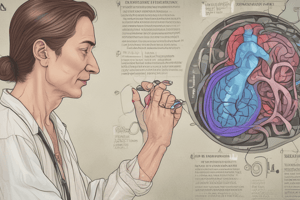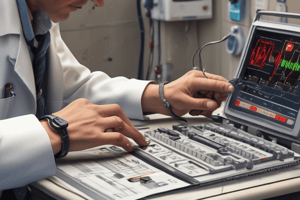Podcast
Questions and Answers
What is not considered a vital sign?
What is not considered a vital sign?
- Heart Rate
- Oxygen Saturation
- Skincare Routine (correct)
- Blood Pressure
Which of the following is an essential aspect of general survey documentation?
Which of the following is an essential aspect of general survey documentation?
- Nearby Medical Facilities
- Blood Pressure Reading
- Report on Weather Conditions
- Patient's Mood and Affect (correct)
Which parameter is not assessed when evaluating a patient's physical appearance?
Which parameter is not assessed when evaluating a patient's physical appearance?
- Facial Expression
- Posture
- Nutritious diet (correct)
- Dress
What is indicated by the upper number in a blood pressure reading?
What is indicated by the upper number in a blood pressure reading?
Which of the following factors is least relevant during the pain assessment process?
Which of the following factors is least relevant during the pain assessment process?
Which vital sign is primarily used to measure the respiratory function of a patient?
Which vital sign is primarily used to measure the respiratory function of a patient?
Which body structure aspects should be noted during a general survey?
Which body structure aspects should be noted during a general survey?
What does the term 'LOC' refer to in a general survey?
What does the term 'LOC' refer to in a general survey?
What is considered a normal SpO2 level?
What is considered a normal SpO2 level?
Which of the following is NOT part of the 'Sixth Vital Sign' pain assessment?
Which of the following is NOT part of the 'Sixth Vital Sign' pain assessment?
Which of the following describes the purpose of documentation in patient care?
Which of the following describes the purpose of documentation in patient care?
What does the 'R' in the DAR note framework stand for?
What does the 'R' in the DAR note framework stand for?
Which of the following pain scales is characterized as 'squeezing'?
Which of the following pain scales is characterized as 'squeezing'?
What indicates a normal blood pressure reading?
What indicates a normal blood pressure reading?
What is considered stage 1 hypertension?
What is considered stage 1 hypertension?
Which condition is indicated by a difference in systolic blood pressure of more than 20 mmHg when moving from supine to standing?
Which condition is indicated by a difference in systolic blood pressure of more than 20 mmHg when moving from supine to standing?
How should the heart rate be assessed during measurement?
How should the heart rate be assessed during measurement?
What is the normal range for heart rate?
What is the normal range for heart rate?
What should be observed regarding the quality of the pulse?
What should be observed regarding the quality of the pulse?
What is a concerning discrepancy in blood pressure between the arms?
What is a concerning discrepancy in blood pressure between the arms?
What does 'Phase 1' signify during blood pressure measurement?
What does 'Phase 1' signify during blood pressure measurement?
What should be the action if the respiratory rate is irregular?
What should be the action if the respiratory rate is irregular?
Which of the following describes a regular rhythm in heart rate?
Which of the following describes a regular rhythm in heart rate?
What is indicated by a systolic pressure of 140 or higher?
What is indicated by a systolic pressure of 140 or higher?
What is the recommended position for a patient when measuring blood pressure?
What is the recommended position for a patient when measuring blood pressure?
Which of the following factors should be considered before taking a blood pressure reading?
Which of the following factors should be considered before taking a blood pressure reading?
What should be done if the patient is lying down during a blood pressure reading?
What should be done if the patient is lying down during a blood pressure reading?
What is considered a hypertensive crisis in terms of systolic pressure?
What is considered a hypertensive crisis in terms of systolic pressure?
What is the purpose of inflating the blood pressure cuff 30 mmHg higher than the point where the radial pulse is obliterated?
What is the purpose of inflating the blood pressure cuff 30 mmHg higher than the point where the radial pulse is obliterated?
What is the significance of diastolic pressure in blood pressure measurement?
What is the significance of diastolic pressure in blood pressure measurement?
Which blood pressure classification indicates high blood pressure stage 1?
Which blood pressure classification indicates high blood pressure stage 1?
Where should the center of the blood pressure cuff bladder be placed?
Where should the center of the blood pressure cuff bladder be placed?
What should be done if the radial pulse is not palpable when measuring blood pressure?
What should be done if the radial pulse is not palpable when measuring blood pressure?
What is the normal respiratory rate for adults?
What is the normal respiratory rate for adults?
Which position might a person assume to help with breathing difficulties?
Which position might a person assume to help with breathing difficulties?
What factor can affect the quality of a patient's breathing?
What factor can affect the quality of a patient's breathing?
Which method of taking temperature is usually considered closest to core body temperature?
Which method of taking temperature is usually considered closest to core body temperature?
What must be done prior to taking an oral temperature?
What must be done prior to taking an oral temperature?
How should a tympanic thermometer be positioned for an accurate reading?
How should a tympanic thermometer be positioned for an accurate reading?
Which temperature measurement method takes the longest?
Which temperature measurement method takes the longest?
What characteristic is typically associated with normal quality of breathing?
What characteristic is typically associated with normal quality of breathing?
What is necessary to ensure when taking an axillary temperature?
What is necessary to ensure when taking an axillary temperature?
What does SpO2 measure?
What does SpO2 measure?
Flashcards are hidden until you start studying
Study Notes
Objectives
- Understand vital signs, how to take them, and interpret results.
- Learn pain assessment techniques.
- Document findings effectively.
- Review focused assessment for integumentary system.
General Survey
- Assess physical appearance, including age, sex, and level of consciousness (LOC).
- Evaluate skin color, facial features, expression, mood, affect, speech, dress, and personal hygiene.
- Examine body structure focusing on stature, build, contour, nutrition, symmetry, posture, body position, gait, and range of motion.
Vital Signs
- Vital signs include blood pressure, heart rate, respiration rate, temperature, oxygen saturation, and pain assessment.
Blood Pressure
- Measures the pressure in arteries during heartbeats (systolic) and between beats (diastolic).
- Categories:
- Normal: Less than 120/80 mm Hg.
- Elevated: 120–129 systolic and less than 80 diastolic.
- Stage 1 Hypertension: 130–139 systolic or 80–89 diastolic.
- Stage 2 Hypertension: 140 or higher systolic or 90 or higher diastolic.
- Hypertensive Crisis: Higher than 180 systolic and/or higher than 120 diastolic (immediate medical attention needed).
Taking a Blood Pressure
- Patient should be seated comfortably; arm level with the heart.
- Consider patient’s caffeine, nicotine intake, and physical activity in the last 30 minutes.
- Use appropriate cuff and select the correct arm.
- Locate brachial artery, position the cuff, and palpate radial pulse.
- Inflate cuff until pulse is obliterated, then relax and inflate again.
- Listen for Korotkoff sounds to determine systolic (Phase 1) and diastolic (Phase 5) pressures.
Interpreting Blood Pressure
- Normal: < 120/80 mm Hg.
- Hypotension: Low blood pressure.
- Orthostatic hypotension: Drop in SBP (>20 mm Hg) or DBP (10 mm Hg) from supine to standing within 3 minutes.
Heart Rate
- Measured using radial pulse focusing on rate, rhythm, and quality.
- Normal range: 60-100 bpm.
- Irregular rhythms require further investigation.
- Assess if all pulses are consistent in strength (strong, weak, or bounding).
Respiratory Rate
- Measures rate, rhythm, and quality of breathing.
- Normal rate: 12-20 breaths per minute.
- Increased work may manifest as use of accessory muscles or changes in posture.
Temperature Measurement
- Normal body temperature around 37°C.
- Measurement methods:
- Oral: Avoid hot/cold liquids and smoking prior; place under tongue.
- Axillary: Lower than oral, takes 5-10 minutes.
- Tympanic: Use appropriate technique for ear canal.
- Rectal: Requires lubrication, insert 3-4 cm.
- Temporal: Sweep across forehead and down to earlobe.
Measuring SpO2
- Indicates hemoglobin saturation with light signals.
- Normal SpO2 above 96%, healthy level above 92%, COPD aim for 88-92%.
Pain Assessment
- Onset, location, duration, characteristics, alleviating/ aggravating factors, radiating nature, timing and treatment, severity/scale, and patient understanding.
- Various descriptors include stinging, cramping, grinding, and more.
Documentation
- Essential for effective communication and safe care.
- Document only care provided, decision-making processes, and use client quotes for clarity.
- Follow professional and legal standards for documentation.
The DAR Note Format
- D - Data:
- Subjective data from patient.
- Objective data from observations or tests.
- Interpretation of current patient status.
- A - Action:
- Document interventions taken.
- R - Response:
- Outcomes resulting from actions taken.
Studying That Suits You
Use AI to generate personalized quizzes and flashcards to suit your learning preferences.




